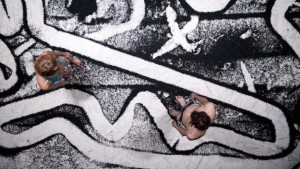I had just struggled to take out my new contact lens (ouch), read an article about a planned new film about Aberfan, looked at the musical Tiger Bay’s coal truck exhibits in Wales Millennium Centre and tripped over a wooden prop holding up the sides of the box into which we look to watch Black Out.
Why am I telling you all of this?
Because every individual has their own unique experience of a dance, and probably every other work, and the above sequence of events set my frame of mind and then coloured my reaction to this production by choreographer Philippe Saire, performed by Maëlle Desclaux, Mickaël Henrotay Delaunay and Benjamin Kahn, in the Dance House at WMC.
Hopefully my pre-show experiences will make some sense, some relevance, to my individual response to the show.
A simple narrative description may have some value although these accompanying photographs (below) are more useful as this work is as much about the creation of pictures and graphic art as it is physical movement in the light (or absence of light) in and over the specially created box designed by Sylvie Kleiber and Laurent Junod.
Once we enter the studio space at the Dance House we climb a simple, steep, slightly wobbly ladder to stand around a pit where the dancers have already created their sculptured shapes, face down, next to beach towels on a stark beach and we can see there is a bank of black crystal gravel-like substance heaped up against one wall of this black hole. Apparently it is rubber pellets but, hey, this is Wales and we are surrounded by our mining heritage.
We are already voyeurs, inspecting these one female and two male bodies in their monochrome bikini and trunks. One creates a squeaking noise as he rubs the plastic flooring and each swing out an arm, move their towels around the space, and, when they roll over, keep their eyes covered from the light. As the roughly one-hour show evolves the black matter starts to pour from what seem miniature coal trucks in the sky although it is hardly likely this was the choreographer’s intention, at first missing each dance until one carries a small quantity on her back. When there is a large amount of this material the dancers start moulding, sweeping, kicking to form a mixture of shapes, patterns, one evolving into another, with the bodies and black shovels forming the designs, pictures.
It is all redolent of cave paintings, of Aboriginal paintings and patterns, of monochrome photographic images (did I mention the Tania D’Ambrogio designed bathing wear and beach towels are of course also monochrome?). It also resembles soft edged graffiti and the origins of chiaroscuro.
The most disturbing scenes involve the female dancer collapsing onto the floor and her body outline being created using one of the shovels which then continues into a softly snaking design throughout the floor. Then, even darker, the male dancers are wearing completely black Ninja-like outfits (including their heads) and, having also been dressed in the same enveloping black clothing, she is buried in the black matter. Ugh. This human mound slowly comes becomes mobile and the granules slide from her revealing body shape.
This soundscape is beguiling, combing the seaside sound of a fun marching tune , perhaps a brass band on a bandstand or a parade, which returns, but then an industrial noise, almost like mechanised whale song, created by Stéphane Vecchione comes into play. Equally important is silence.
By the end of the dancers’ performance my senses were so all over the place, following this real and metaphysical trip, and eyes gritty as if they too were full of the black particles that have also been thrown up into the air, that I was utterly absorbed. But this was not the end of dramatist Roberto Frantini Serafide’s work.
The conclusion of the piece is exquisite and shocking in equal measure.
There was a fad a little while ago for sensory deprivation experiences, floating in water in pods in darkness and silence. In this “pod” at times you have nothing to see, nothing to hear, and (almost) nothing to feel. You are in darkness, awake, and there is nothing there for a few seconds perhaps minutes and the conscious mind.
The last time I remember such sensory deprivation, such utter blackness, such a feeling of death, is in Big Pit, being deep, deep underground in utter blackness. Yet then there we see the subtle lights that have been left in the floor of blackness, juxtaposition the blinding sunlight at the beginning to the cosmic heavens at the conclusion.
So down that steep ladder I descended, having avoided taking another physical trip, and , rubbing my sore eyes, walked into the light.
Wonderful.
Further performances 6pm and 8pm, November 11.
Cardiff Dance Festival opening:
http://asiw.co.uk/reviews/wrongheaded-liz-roche-opening-cardiff-dance-festival
Wrongheaded and In this Moment:
http://asiw.co.uk/reviews/wrongheaded-moment-cardiff-dance-festival-chapter-cardiff
Cardiff Dance Festival:
http://dance.wales/


